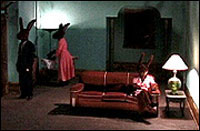|
By employing Rabbits rather
than Humans, it creates a homogenisation of the imagery, this
works well in Lynch’s favour as it denudes the characters
of all familiar characteristics and identification and therefore
forces the audience to focus on and evaluate the mechanics
of construction. This alienating device makes the narrative
rather than the characters the focal point of interest. We
can now enter the world of the metaphysical and concentrate
on the structure of the presentation.
As of this writing Rabbits
has aired eight episodes of an ongoing series (Lynch has not
divulged the exact number of episodes which will comprise
the full set), which lasts approximately five minutes each.
As with a great deal of Lynch’s works, Rabbits is not
easy to encapsulate in narrative terms. It may superficially
be mimicking the sitcom genre but themes of alienation and
connection are the nucleus of this intriguing representation
of metaphysics. Ever since his debut feature film Eraserhead,
his body of work has been evolving into an ever complex fracturing
of the human psyche. Lynch’s psychological excursions into
inner space have always been a thematic concern for him (see
the polarisation of opposites in Blue Velvet
and Twin Peaks) but it is with the recent movies
Lost Highway and Mulholland Drive
that he has expanded and taken identity crises into blurred
unconfined terrains.
| |
 |
|
|
The tag line that describes
Rabbits on
www.davidlynch.com is “In
a nameless city, deluged by continuous rain, three rabbits
live with a fearful mystery”. Mysteries are of course
a quintessential theme that enables him to evade narrative
resolution and concentrate on mood and atmosphere. The setting
of this living room is very minimalist (keeping in fashion
with Lynch’s real life interior décor) with only a few requisite
props to pad out the ambience : a sofa, a telephone,
a lampshade and an ironing board. This décor gives the appearance
of a theatrical presentation and suits the subtext of artificiality
and existentialism. These limitations form an artistic challenge
for Lynch, who has gone on record as saying he enjoys restrictions
as they help to create an artistic environment to work under
(7). To this purpose Lynch has always been a master
at magnifying and enhancing the dynamics of a room and giving
it mood. (Take for example the scene in the pilot episode
of Twin Peaks in which Laura Palmer’s school
friends become aware of her death : Lynch focuses his
camera on her empty classroom chair, and with a combination
of sounds that resemble the wind, wonderful acting and skilful
editing, her absence is conveyed to her colleagues in a subtle
and profound way). In Rabbits, Lynch embraces the constraints
of a singular set design and imbues every move, every utterance
with loaded meaning. This situation has been dealt with before
in two episodes of the claustrophobic Hotel Room
written by his Lost Highway writing partner Barry
Gifford for HBO television, but here in Rabbits he
really takes the ball and runs. In the book Lynch On
Lynch, he states that “As soon as you capture some
space and design how the shape of it is, moods start occurring,
lights start playing on the wall, and just to see it happening
is unbelievable !” (8).
Shortly in Rabbits, the viewer will bear witness to
the economical skill in which Lynch utilises, explores and
opens up the limitations of confined space : he achieves
this feat by creating an eerie atmosphere with sound, light,
shadows, dialogue, repetitious body movements and pacing.
|